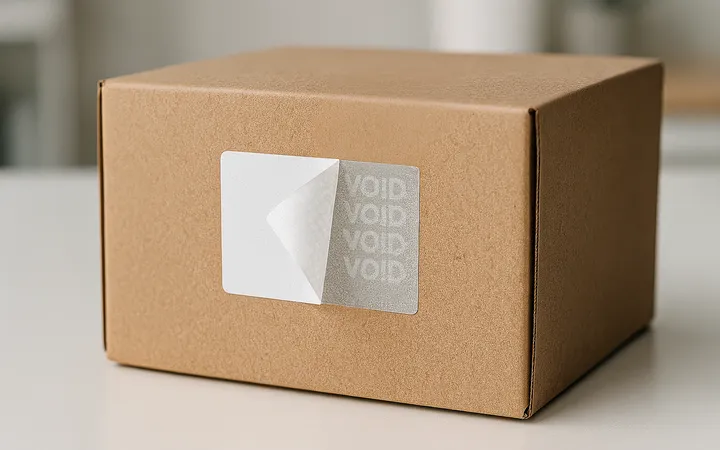
Labels and GDPR Compliance: Essential Guidelines for Businesses
Key Takeaways
- GDPR compliance requires clear labelling of data collection practices on product packaging and labels
- Security labels and tamper-evident packaging are essential for protecting personal data integrity
- Proper labelling helps businesses demonstrate transparency and build consumer trust
- Cosmetic products require specialised GDPR-compliant labelling due to their unique data collection practices
- Material selection for labels is crucial to ensure durability and long-term compliance
- Transparent labels must balance aesthetic appeal with comprehensive GDPR information
- Removable labels offer flexibility when regulatory requirements change
- Multi-layered approaches can help overcome space limitations on smaller products

Introduction to GDPR and Product Labelling Requirements
The General Data Protection Regulation (GDPR), established in 2016 and enforceable since May 25, 2018, has changed how businesses handle personal data. For product makers and sellers, this goes beyond digital data to include physical product labelling. Good labelling isn't just for marketing - it's now a legal requirement that shows businesses are following GDPR rules. The regulation sets strict guidelines for how organisations collect, process, and protect personal information, affecting product packaging across all industries.
GDPR applies to any organisation processing personal data of EU residents, no matter where the company is located. With fines up to €20 million or 4% of annual global revenue, following these rules isn't optional. For manufacturers and retailers, this means product labels must clearly show how customer data is collected, processed, and what rights consumers have. These significant penalties show why it's important to have good labelling that clearly tells consumers how their data is handled.
Product labels must now include information about what personal data is collected when consumers buy or use products, how this data will be used, and who to contact with data concerns. This is especially important for products that collect data directly (like electronic devices) or indirectly (through warranty cards, loyalty programmes, or QR codes). This applies to almost all consumer goods, since even simple products might collect data through marketing promotions, warranty registrations, or customer feedback forms.
Proper labelling for GDPR compliance requires careful thinking about design, materials, and how information is presented. Let's look at how different types of labels can help businesses meet their GDPR duties whilst keeping their brand look and product function. From security features that protect data to special materials that ensure labels last in different environments, good GDPR-compliant labelling combines knowledge of the rules with practical design ideas.
Security Labels and Data Protection
Security labels play an important role in GDPR compliance by protecting packages that contain personal data or products that might collect personal information. These special labels help prevent tampering and unauthorised access, which GDPR requires for data security. Article 32 of the GDPR specifically requires putting in place proper technical and organisational measures to ensure data security, which includes physical protection for products that contain or collect personal information.
Our security labels are made with features that show if someone has tampered with them, helping businesses protect sensitive information and follow GDPR's security requirements. These labels come in several types, each offering different security levels and ways to show if someone tried to tamper with them. The technology behind these labels has gotten much better in recent years, giving better protection against unauthorised access to personal data.

1. Self-destructing paper security labels - These labels break apart when someone tries to remove them, clearly showing tampering. The special glue and paper combination ensures the label can't be removed in one piece, making unauthorised access obvious.
2. PET security labels - Available in white, transparent, or hologram finishes, these tough film labels offer better security features and resist environmental factors like moisture and temperature changes.
3. Void effect labels - When removed, these labels show the word "VOID" or custom text, making tampering immediately obvious. The chemical technology ensures the void pattern can't be faked or removed.
4. Original lettering labels - These advanced labels show custom text when tampered with, allowing for brand-specific security messages that match company identity whilst maintaining security.
The importance of tamper-evident packaging goes beyond just GDPR compliance. As shown in our article on pharmaceutical packaging, security features help maintain product integrity and consumer trust. For products containing personal data or devices that collect such information, tamper-evident packaging shows a commitment to data protection and helps prevent unauthorised access that could lead to data breaches.
For businesses handling sensitive personal data, our security labels can be made within 48 hours, allowing for quick setup of better security measures. Whether you're protecting physical documents with personal information or securing products that might collect consumer data, these labels visibly show your commitment to data protection. This quick production is especially valuable for businesses that need to respond quickly to security problems or changes in regulations.
Transparent Labelling for GDPR Transparency Requirements
GDPR puts a lot of emphasis on being open about data collection and processing. This applies to product labelling too, where clear communication about data practices is essential. Transparent labels offer a nice solution for businesses that need to include required GDPR information without making their products look bad. Article 12 of the GDPR specifically requires that information about data processing be provided in a "concise, transparent, intelligible and easily accessible form, using clear and plain language" – a requirement that directly affects label design and content.
Our transparent labels create a "no-label" look whilst still showing all required information. These clear labels are especially useful for creating a seamless appearance that keeps product visibility whilst following regulations. The innovative materials used in these labels allow for high-quality printing that stays readable whilst minimising visual impact on the product design.
- Creating a premium, unobtrusive appearance on high-end products where maintaining aesthetic appeal is critical to brand positioning
- Maintaining product visibility whilst including mandatory GDPR disclosures, allowing consumers to see product contents or features
- Achieving a seamless look on glass, plastic, or other transparent containers without disrupting the visual appeal of the packaging
The PP film material used in our transparent labels provides optimal fit and moisture resistance, making them ideal for products that may be exposed to varying conditions. This durability ensures that GDPR-required information remains legible throughout the product lifecycle. The advanced adhesive technology used in these labels maintains clarity and adhesion even in challenging environments such as refrigeration, humidity, or frequent handling.
For products packaged in transparent stand-up pouches, GDPR compliance information can be printed directly on the packaging or applied via clear labels. These pouches offer excellent visibility of contents whilst providing ample space for required disclosures about data collection and processing. The flexible nature of these pouches allows for creative layout solutions that incorporate GDPR information without compromising the visual appeal of the product.
When designing transparent labels for GDPR compliance, consider the following expert recommendations to ensure both regulatory compliance and aesthetic appeal:
- Using contrasting ink colours to ensure text legibility against the product background, with careful testing under various lighting conditions
- Incorporating QR codes that link to more detailed privacy information, reducing the amount of text needed on the label itself
- Balancing mandatory information with brand aesthetics through thoughtful typography and layout design
- Ensuring all text meets minimum size requirements for readability, typically no smaller than 8-point font for essential information
- Testing label performance in various environmental conditions to ensure long-term legibility and adhesion
GDPR-Compliant Labelling for Cosmetic Products
The cosmetic industry faces unique challenges regarding GDPR compliance. Cosmetic products often collect sensitive personal data through loyalty programmes, online registrations, and customer feedback. They also frequently contain ingredients that may require specific disclosures. Our cosmetic labels are designed to meet these specialised requirements. The cosmetic industry is particularly affected by GDPR due to the personal nature of these products and how often companies collect data for personalisation and marketing purposes.
Cosmetic product labels must now include complete information about data practices, going beyond traditional ingredient and safety disclosures. This additional information must be presented clearly and accessibly, often requiring innovative label designs to fit all required content.
- What personal data is collected during purchase or product registration, including any biometric or health-related information
- How this data will be used and stored, including any third-party processing or international transfers
- Consumer rights regarding their personal data, including access, rectification, and deletion options
- Contact information for data protection enquiries, including the Data Protection Officer when applicable
Our custom-printed cosmetic labels are designed for bottles and jars of skincare products, make-up, and perfumes, with materials that stay stuck even with moisture and contact with creams and oils. This durability ensures that GDPR-required information remains intact throughout product use. The specialised adhesives used in these labels are formulated to resist oils, alcohols, and other ingredients commonly found in cosmetic products, preventing label degradation that could compromise GDPR compliance.

For smaller cosmetic items like lipsticks and balms, space constraints can make GDPR compliance challenging. Our specialised small-format labels are designed to fit perfectly on these items whilst still containing essential information. These labels utilise innovative space-saving designs and printing techniques to maximise information density without compromising readability.
- QR codes linking to detailed privacy information, providing a space-efficient way to direct consumers to comprehensive disclosures
- Layered or peel-back labels that reveal additional information when lifted, effectively doubling the available space for disclosures
- Reference to packaging or inserts that contain complete GDPR disclosures, creating an integrated compliance system across all packaging components
- Micro-text printing techniques that maintain legibility whilst reducing space requirements for secondary information
All our cosmetic labels can be fully customised in size and finish, allowing brands to maintain their aesthetic whilst meeting regulatory requirements. With production times as quick as 48 hours, businesses can rapidly implement GDPR-compliant labelling solutions. This customisation extends to shape, material, finish, and printing techniques, ensuring that compliance doesn't come at the expense of brand identity or product appeal.
Removable Labels for Flexible GDPR Compliance
As GDPR requirements evolve and businesses update their data practices, having flexible labelling solutions becomes increasingly important. Removable labels offer an adaptable solution that allows companies to update compliance information without replacing entire packaging runs. This flexibility is particularly valuable given the ongoing development of GDPR interpretation through regulatory guidance and court decisions.
Our removable labels feature pressure-sensitive adhesive suitable for both indoor and outdoor use. They can be applied to existing packaging and removed cleanly when information needs to be updated. This solution is particularly valuable for addressing the dynamic nature of data protection regulations and business practices. The specialised adhesive technology ensures that labels can be removed without leaving residue or damaging the underlying packaging, maintaining product appearance through compliance updates.
- Products with long shelf lives that may see GDPR requirement changes during their market presence, such as durable goods or non-perishable items
- Businesses transitioning to full GDPR compliance who need temporary labelling solutions whilst developing more permanent packaging changes
- Products sold across different jurisdictions with varying data protection requirements, allowing for market-specific compliance without separate production runs
Available in both paper and film materials, these labels can be customised to match brand aesthetics whilst providing the necessary flexibility for regulatory compliance. The ability to update information without discarding packaging aligns with both economic and environmental sustainability goals. The paper options provide excellent printability for detailed text, whilst film materials offer enhanced durability for challenging environments or longer-term applications.
For companies that need to include substantial GDPR information but have limited packaging space, our consultants can recommend specialised solutions like multi-layer labels or booklet labels that expand to reveal detailed information whilst maintaining a clean look when closed. These innovative label formats can contain up to 60 pages of information in a compact format, making them ideal for products that require extensive disclosures about data collection and processing practices.
Packaging Solutions for Comprehensive GDPR Information
When products require extensive GDPR disclosures that won't fit on a standard label, specialised packaging solutions become necessary. Our range of folding boxes with tuck-in flaps and folding boxes with separators provide ample space for detailed privacy information. These packaging solutions are particularly valuable for products with complex data collection practices or those subject to multiple regulatory frameworks.
These packaging solutions offer several advantages for GDPR compliance, combining practical functionality with comprehensive information presentation. The structural design of these packages provides multiple surfaces for printing detailed information whilst maintaining an organised, user-friendly format.
- Ample space for detailed information - The interior surfaces of folding boxes provide significant additional area for privacy notices and data collection disclosures, effectively multiplying the available space compared to labels alone
- Organisation of complex information - Boxes with separators allow for logical organisation of different aspects of GDPR compliance, making information more accessible to consumers
- Protection of enclosed privacy documentation - Sturdy packaging protects any included privacy leaflets or documentation from damage during shipping and handling
- Consumer retention of information - Consumers are more likely to keep boxes than to retain loose inserts or labels, improving long-term access to privacy information
For products that require even more detailed privacy information, folded inserts can be included within packaging. These inserts can be designed with wraparound, zigzag, or parallel folds to organise comprehensive GDPR disclosures in a user-friendly format. The specialised printing and folding techniques used in these inserts allow for significant information density whilst maintaining readability and logical organisation.
Hanging boxes with snap-lock bases offer an additional advantage for retail display whilst providing space for GDPR information. These boxes feature Euro hole hangers and interlocking flaps, making them ideal for products that need to communicate privacy information clearly at the point of sale. The structural design combines display functionality with secure closure, ensuring that privacy information remains protected until the consumer accesses the product.
Specialised Labels for Food and Beverage GDPR Compliance
Food and beverage products present unique GDPR challenges, especially when they involve customer loyalty programmes, QR codes that collect data, or personalised product offerings. For these industries, specialised packaging solutions like stand-up pouches for coffee can be designed with GDPR compliance in mind. The food and beverage sector often collects consumer preference data, dietary information, and other personal details that fall under GDPR protection requirements.
Our food-safe packaging solutions provide plenty of space for GDPR-required disclosures whilst maintaining product freshness and appeal. For coffee producers and other food businesses that collect customer data through various touchpoints, these packages offer an integrated approach to compliance and product protection. The specialised barrier properties of these packages preserve product quality whilst providing extensive printable surfaces for regulatory information.
- Loyalty programmes that track purchasing patterns and preferences for personalised marketing
- Online registration for product information, warranties, or exclusive content access
- Customer feedback mechanisms that collect personal opinions and contact information
- QR codes linking to digital content that may involve cookies or other tracking technologies
- Subscription services that process payment and delivery information
These packages can be printed with all necessary GDPR information directly on the packaging, eliminating the need for additional labels. The food-safe, odourless, and tasteless materials ensure that product quality is maintained whilst meeting regulatory requirements. Advanced printing technologies allow for high-resolution graphics and text that remain clear and legible throughout the product lifecycle, even in challenging environments like refrigeration or high humidity.
For products that require barcode scanning or digital interaction, specialised labels with appropriate GDPR disclosures about data collection during scanning can be incorporated into the design. These labels maintain scannability whilst providing necessary privacy information. The technical specifications of these labels ensure that barcode readability is not compromised by additional text or graphics, maintaining efficient scanning whilst complying with GDPR disclosure requirements.
Label Application and Management for GDPR Compliance
Implementing GDPR-compliant labelling across product lines requires efficient application and management systems. Our table label dispensers and thermal transfer printing supplies help businesses efficiently apply and manage compliant labels. These tools are essential for maintaining consistency and quality in label application, particularly when implementing new GDPR-compliant labelling across multiple product lines.
Our table-top label dispensers enable efficient manual application of GDPR-compliant labels, with features designed to improve productivity and application consistency. These ergonomic devices reduce application time whilst ensuring proper placement of labels containing critical GDPR information.
- Usable width of 250 mm to accommodate various label sizes, from small cosmetic product labels to larger packaging disclosures
- Compatibility with both inside and outside wound rolls, providing flexibility in label procurement and inventory management
- Easy removal mechanism with a light pull on the backing film, reducing application time and improving ergonomics for production staff
- Durable metal construction that withstands continuous use in production environments
For businesses that need to print variable GDPR information on labels (such as different data controllers for different markets), our thermal transfer wax ribbons provide high-quality printing solutions. These ribbons are suitable for all paper labels and produce clear, durable text that remains legible throughout the product lifecycle. The precision printing capabilities ensure that even small text remains readable, which is crucial for GDPR disclosures that often contain detailed information in limited space.
Efficient label management is crucial for maintaining GDPR compliance, especially when requirements change or are updated. Our systems help businesses implement comprehensive label management strategies that ensure continuous compliance whilst minimising disruption to production processes.
- Track which products have current GDPR-compliant labelling through systematic inventory and production management
- Quickly update labels when regulations or company data practices change, maintaining compliance without excessive waste
- Maintain consistency across product lines to ensure uniform GDPR disclosures across all consumer touchpoints
- Efficiently implement new labelling requirements with minimal disruption to production schedules and supply chains
The New Packaging Act and Its Relationship to GDPR
The implementation of the new packaging act creates additional considerations for businesses already working to comply with GDPR. Whilst these regulations have different main focuses, they overlap in several important ways that affect product labelling. This regulatory overlap requires an integrated approach to compliance that addresses both data protection and environmental responsibilities.
The packaging act requires specific information about materials, recycling, and environmental considerations, whilst GDPR requires disclosures about data collection and processing. When designing labels and packaging that must comply with both regulations, businesses face the challenge of communicating multiple types of regulatory information without overwhelming consumers or compromising product aesthetics.
- Integrated compliance design - Create labels that address both sets of requirements in a cohesive, user-friendly format that organises information logically and maintains brand consistency
- Space optimisation - Use available packaging space efficiently to include all required information without creating cluttered, confusing designs that diminish consumer experience
- Hierarchical information presentation - Organise disclosures logically so consumers can find both environmental and data privacy information quickly and easily
- Consistent visual language - Develop a consistent approach to presenting regulatory information that helps consumers recognise and understand different types of disclosures
Our packaging solutions are designed with these multi-regulatory considerations in mind, helping businesses meet all applicable requirements without compromising brand aesthetics or consumer experience. The integrated approach ensures that consumers receive all required information in a format that remains accessible and understandable, enhancing transparency whilst maintaining product appeal.
Implementing GDPR-Compliant Labelling: Best Practices
Based on our experience helping businesses implement GDPR-compliant labelling, we've developed several best practices that ensure effective compliance whilst maintaining brand integrity and customer experience. These recommendations reflect both regulatory requirements and practical considerations for successful implementation across different product categories and business contexts.

Audit Current
Labels
Review existing labels for GDPR gaps and compliance issues

Identify Data Collection Points
Map all customer data collection throughout product lifecycle

Design for
Clarity
Create labels that communicate privacy information clearly

Establish Update Procedures
Develop processes for updating labels when GDPR requirements change
When implementing GDPR-compliant labelling, we recommend a systematic approach that addresses both regulatory requirements and practical business considerations. This comprehensive strategy ensures effective compliance whilst minimising disruption to existing operations and brand identity.
1. Conduct a comprehensive label audit
Begin by reviewing all existing product labels to identify what personal data is collected through product purchase, registration, or use, and ensure this is clearly disclosed. This audit should examine not just the labels themselves but all associated materials including packaging, inserts, and digital touchpoints that may be referenced on labels. Document any gaps between current disclosures and GDPR requirements to prioritise updates.
2. Prioritise clarity and accessibility
GDPR information should be presented in clear, plain language that consumers can easily understand. Avoid legal jargon and overly technical terms. Test label text with representative consumers to ensure comprehension, and consider using internationally recognised icons or symbols to supplement text where appropriate. Pay particular attention to font size, contrast, and readability under various lighting conditions.
3. Use layered information approaches
For products with space constraints, consider using a layered approach where essential information appears on the product with references to more detailed information elsewhere (website, package insert, etc.). This approach, endorsed by many data protection authorities, allows for comprehensive disclosures without overwhelming product labels. Ensure that links to digital information remain functional throughout the product lifecycle.
4. Maintain consistent branding
Design GDPR-compliant labels that integrate seamlessly with your brand aesthetics. Compliance doesn't have to compromise visual appeal. Work with designers who understand both regulatory requirements and brand guidelines to create labels that satisfy both. Consider how typography, colour, and layout can be used to present regulatory information in a way that complements rather than conflicts with brand identity.
5. Implement version control
As GDPR interpretations and requirements evolve, maintain clear version control for all label designs to track compliance updates. Establish a systematic approach to version management that includes dating all label designs, documenting changes, and maintaining archives of previous versions. This documentation is invaluable during regulatory reviews or audits.
6. Train staff on compliance requirements
Ensure that design, marketing, and production teams understand GDPR labelling requirements to prevent non-compliant labels from entering production. Develop clear guidelines and approval processes for label content, and conduct regular training updates as regulatory interpretations evolve. Designate specific individuals responsible for GDPR compliance review before labels enter production.
7. Consider multilingual requirements
For products sold across multiple EU countries, ensure labels include GDPR information in all relevant languages or use clear icons and symbols where appropriate. Work with professional translators familiar with GDPR terminology to ensure accuracy in all languages. Test multilingual labels with native speakers to verify clarity and cultural appropriateness before final production.
Conclusion: Balancing Compliance and Brand Experience
GDPR compliance in product labelling is a significant challenge for businesses, but with the right approach, it can be an opportunity to show transparency and build consumer trust. Our range of labelling and packaging solutions helps businesses meet these regulatory requirements whilst maintaining brand integrity and product appeal. By seeing GDPR compliance as part of customer service rather than just a legal requirement, businesses can improve their reputation for respecting consumer privacy.
From security labels that protect data integrity to transparent labels that maintain product aesthetics, our solutions are designed to address the specific challenges of GDPR compliance. For industries with unique requirements, such as cosmetics or food and beverage, we offer specialised options like cosmetic labels and stand-up pouches that provide both compliance and appeal. These industry-specific solutions reflect our understanding of both regulatory requirements and market expectations.
Effective GDPR-compliant labelling requires thoughtful design, appropriate materials, and efficient application systems. By partnering with Labelprint24, businesses can navigate these complex requirements with confidence, ensuring that their products not only comply with regulations but also continue to engage and delight consumers. Our consultative approach helps businesses develop integrated compliance strategies that address all aspects of labelling, from material selection to application methods.
As data protection regulations continue to evolve, our commitment to innovation ensures that we will continue to develop new labelling solutions that help businesses stay compliant whilst maintaining their competitive edge in the marketplace. This forward-looking approach helps businesses not just react to current requirements but prepare for future regulatory developments, creating sustainable compliance strategies that support long-term business objectives.




